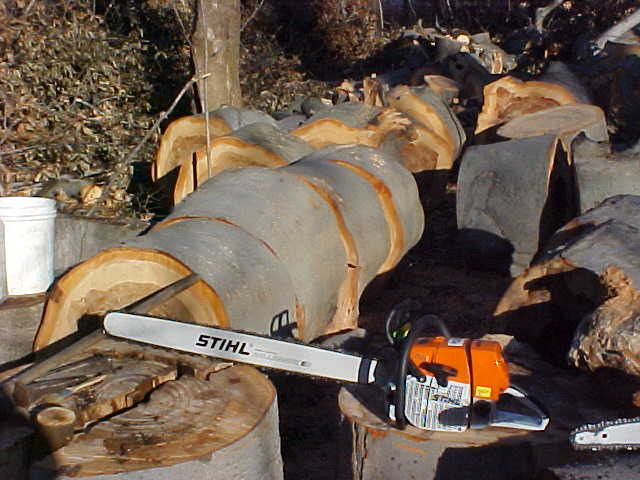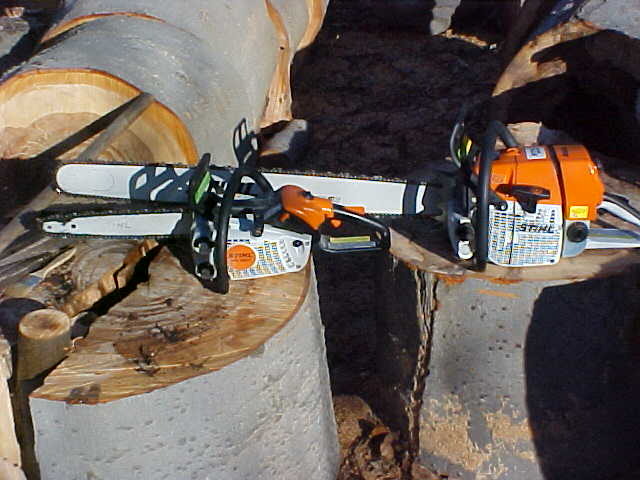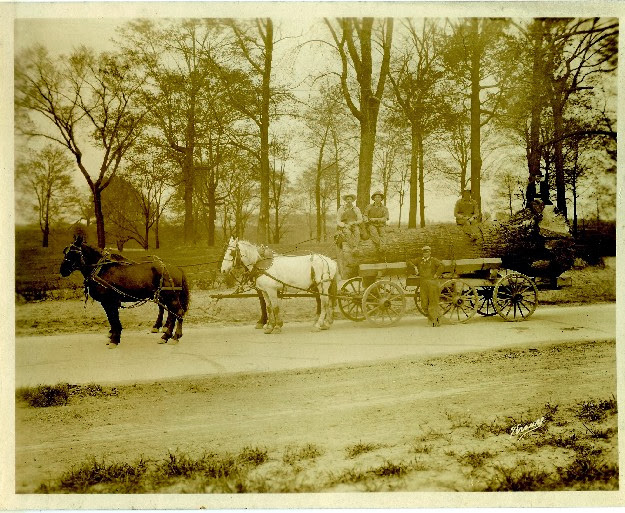Might have been posted before but new to me. Thought others would find it interesting as well.
You are using an out of date browser. It may not display this or other websites correctly.
You should upgrade or use an alternative browser.
You should upgrade or use an alternative browser.
Found a nice video of old logging
- Thread starter Kevin in Ohio
- Start date

Help Support Arborist Forum:
This site may earn a commission from merchant affiliate
links, including eBay, Amazon, and others.
philoshop
Addicted to ArboristSite
Thanks for the great video!!
I'll remember it the next time I think my saw's getting a little heavy at the end of the day!
I'll remember it the next time I think my saw's getting a little heavy at the end of the day!
Wow! Those are some men and logs. The equipment they had sure took a lot of MAN power... I think I saw the end of the old growth cutting in the late 1970s. Two or three logs per truck were still common then, but the logs in this clip were even bigger!
I like the Bob Wills music too! ;-)
I like the Bob Wills music too! ;-)
When you click on the link, be sure to look at the sidebar links to other videos as there are some real good ones there.
I can't imagine the scope of what they did. I've done a few decent size ones but pretty rare to see.

I can't imagine the scope of what they did. I've done a few decent size ones but pretty rare to see.

Might have been posted before but new to me. Thought others would find it interesting as well.
Thank you very much. Enjoy those old logging videos.
Speechless. Thanks for sharing
Jim Timber
1/4 bubble off
When you click on the link, be sure to look at the sidebar links to other videos as there are some real good ones there.
I can't imagine the scope of what they did. I've done a few decent size ones but pretty rare to see.

This photo makes me want to leave my wolf trees alone.
Gavman
ArboristSite Operative
Thats the area where I live now, there are about maybe 10 stumps in my yard from 80 to 90 years ago that were old growth cedar... you can still see the notches in the stumps where they fitted the springboards.
Believe it or not they are still cutting old growth in my area still, Iv seen more than once one log loads in the recent years.
There was just an area about 2 miles from my house that was slated to be logged but the locals managed to get it stopped just last month, that would have been quite a few one log loads...
Logging is still as tough and dangerous as it was back then in many ways, better equipment for sure but the trees are still heavy and the winches although stronger, cables still snap etc etc...
There is one local log truck that carries maybe 150 footers to market, the trailer has a steering station in between the back axles where the guy in there gets paid more than the truck driver... (he looks like bubbles from the trailer park boys too with his jam jar glasses lol )
Its good to live here in the big timber forests, and these loggers make for some good neighbours...
Believe it or not they are still cutting old growth in my area still, Iv seen more than once one log loads in the recent years.
There was just an area about 2 miles from my house that was slated to be logged but the locals managed to get it stopped just last month, that would have been quite a few one log loads...
Logging is still as tough and dangerous as it was back then in many ways, better equipment for sure but the trees are still heavy and the winches although stronger, cables still snap etc etc...
There is one local log truck that carries maybe 150 footers to market, the trailer has a steering station in between the back axles where the guy in there gets paid more than the truck driver... (he looks like bubbles from the trailer park boys too with his jam jar glasses lol )
Its good to live here in the big timber forests, and these loggers make for some good neighbours...
This photo makes me want to leave my wolf trees alone.
I've shown that tree before but the pics got lost in the hacking. When Hurricane Ike's wind made it through Ohio it really hit us hard and that tree was one of them. You can't see it in that pic but it blew the whole top out and it was healthy with no rot, which is rare for a Beech. It was a 30 ft totem pole.

Here is a pic of the 2 limbs that Y off at that point. One was 3 ft and the other was close to 4ft.

That's a 3 ft bar on the MS660

We cut the top all up and left the totem go to see if it would sprout any leaves. It didn't and we cut it up 2 years later. Just a little over 5ft in diameter and we figured over 400 years old by the rings. Over 15 cord in ONE tree.


This is the biggest survivor now. A sycamore that is getting close to 5 ft. There are 5 trees within 150 ft that are 3 1/2 ft or bigger. Sycamores love creeks!

Here is the twins across the creek. Over 7 1/2 ft of solid wood at the bottom.

Leaf size gives you an idea how healthy the one on the lane is.
Last edited:
leadarrows
Tree Freak
F
fuzz1500
Guest
Great vid and pics . Thanks for sharing !!!
Awesome vid. Check out the meat at 13 1/2 minutes. No 'gym muscle' there. That there is a man for ya. I bet he could outwork any five of us.
Icehouse
ArboristSite MVP
That was a great video, I watched twice to see what I may have missed. The area I live in went through that era, but timber not so big, some one log loads but not to many. In the early days lots of the logging was done in the winter, skidding was done by horses with ice shoes, log slid much easier on a snow trail. Logs where skidded to the lake, boomed, towed by tug to the mouth of the river, stored till spring, then floated down river on spring snow run off water. It has been said that the average calorie intake for a logger here in those days was 12 to 14 thousand, the camp cook was really well respected. Love those old movies, thanks.
Logging the big punkins was still going on here when I first came here to cruise timber. Imagine my surprise when my D-tape was too short to measure diameter without sticking it in again and adding. I started out cruising windthrow. There'd been a big storm in 1984 in this area and a lot of timber was on the ground. I wish I'd carried a camera.
Note the 6 foot long scaling stick carried by the scaler in the first part. I would take one just like it with me when I met with a group of school kids on a sale. Whap that spud into a log and it gets their attention, along with a bit of waving around.
The next year I switched over to the logging admin. side of things and got quite an education on getting those logs out of the woods and onto trucks. One thing has not changed since the 80s, and that is the pay. The pay for the rigging crew has not increased since that time. It used to be excellent money. It is now so-so pay.

Note the 6 foot long scaling stick carried by the scaler in the first part. I would take one just like it with me when I met with a group of school kids on a sale. Whap that spud into a log and it gets their attention, along with a bit of waving around.
The next year I switched over to the logging admin. side of things and got quite an education on getting those logs out of the woods and onto trucks. One thing has not changed since the 80s, and that is the pay. The pay for the rigging crew has not increased since that time. It used to be excellent money. It is now so-so pay.

Vermonster
ArboristSite Operative
Those were some rugged fellers back then. That was a period of time when men were men and sheep were scared.
MuskokaSplitter
ArboristSite Operative
the Conditions they worked in back then would probably be appalling to most today. Nice video.
The spar trees and old growth sized equipment took a half day to a day to rig up. Think 6 to 8 guylines, each tied off to a suitable stump. Today's smaller timber can be yarded with smaller equipment, some with only 2 or 3 guylines. Lines are smaller and lighter. Whistles are still used, but a talkie tooter replaced the whistle punk. Yarders can be moved and set up in an hour, if things go right.
I only had this crew around a week. They were moving pretty fast for downhill yarding, which I figure moves half the volume as conventional uphill yarding. You'll hear the whistles and the hooktender conversing with the chaser (landing guy). My video is shakey because I'm trying to film but I'm also trying to keep alert as to what is happening on the landing.
I only had this crew around a week. They were moving pretty fast for downhill yarding, which I figure moves half the volume as conventional uphill yarding. You'll hear the whistles and the hooktender conversing with the chaser (landing guy). My video is shakey because I'm trying to film but I'm also trying to keep alert as to what is happening on the landing.
That was a great video, I watched twice to see what I may have missed. The area I live in went through that era, but timber not so big, some one log loads but not to many. In the early days lots of the logging was done in the winter, skidding was done by horses with ice shoes, log slid much easier on a snow trail. Logs where skidded to the lake, boomed, towed by tug to the mouth of the river, stored till spring, then floated down river on spring snow run off water. It has been said that the average calorie intake for a logger here in those days was 12 to 14 thousand, the camp cook was really well respected. Love those old movies, thanks.
I caught what I think was the last log drive down the North fork of he Clearwater River in the 50s or early 60s. Home on leave from the AF. Folks house fronted on the river in Ahsahka, Idaho.
Harry K
Similar threads
- Replies
- 11
- Views
- 2K
- Replies
- 3
- Views
- 382
- Replies
- 11
- Views
- 1K
- Replies
- 18
- Views
- 2K
- Replies
- 10
- Views
- 1K




